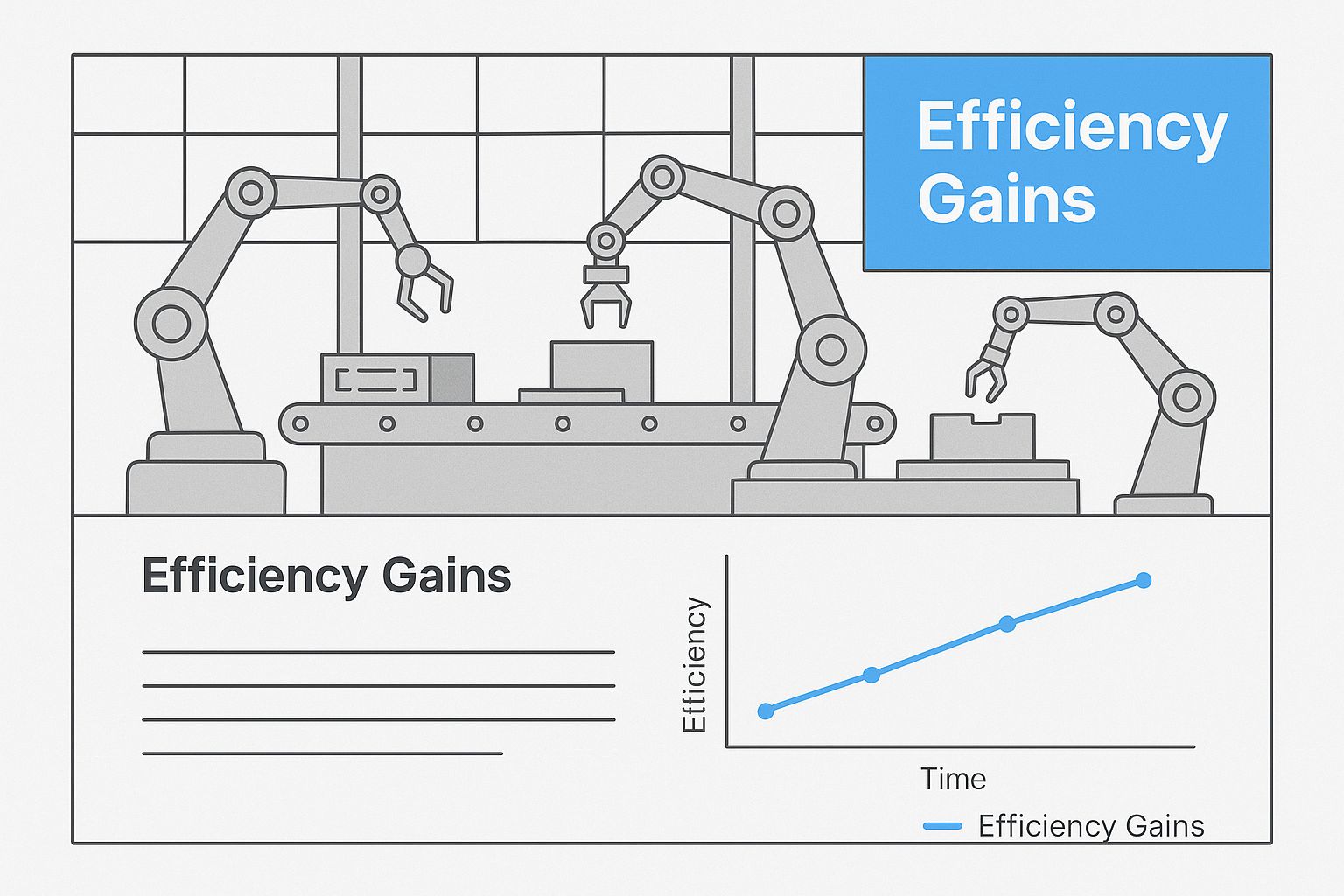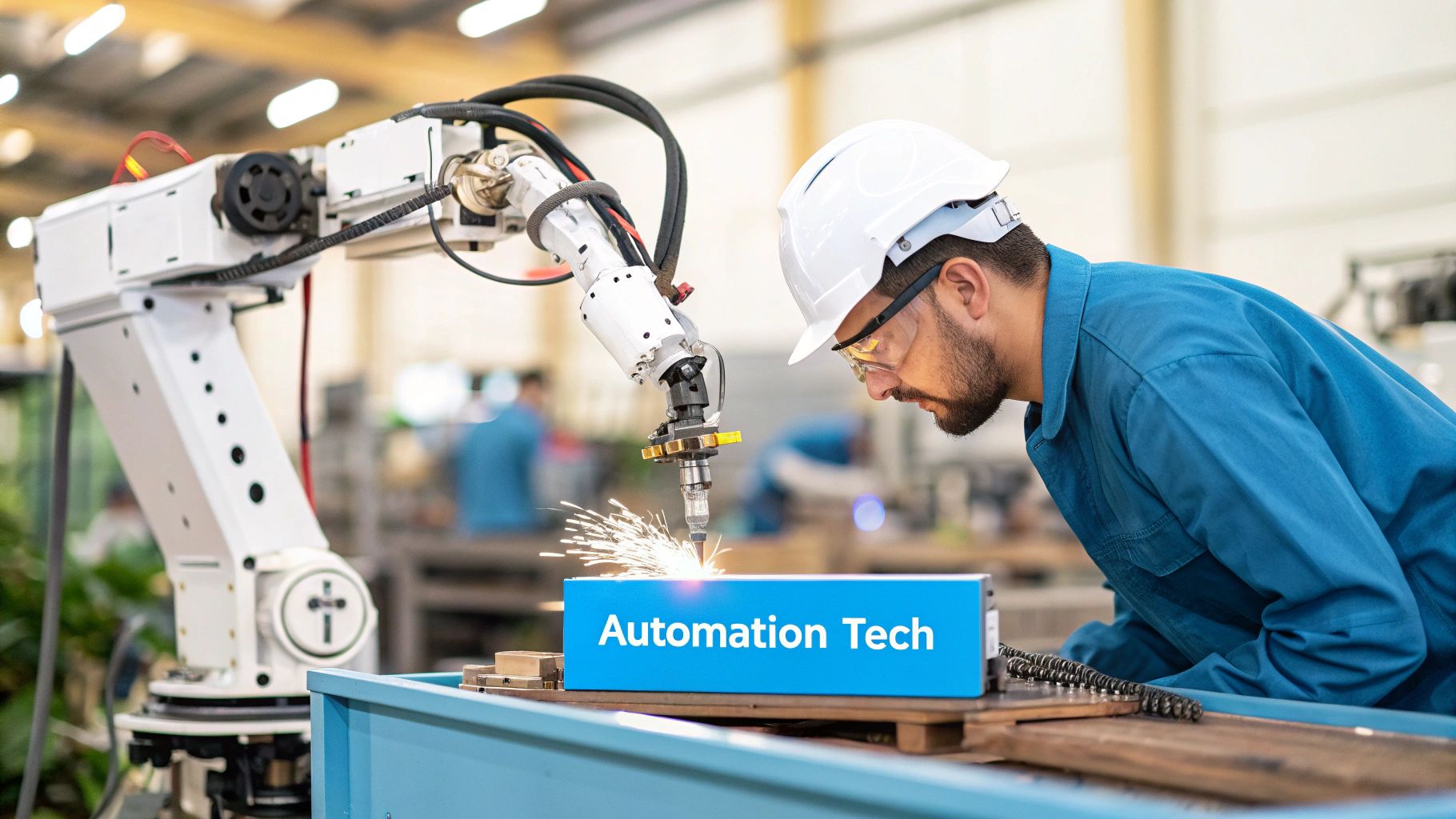Enhance Efficiency with Automation in Manufacturing Process
Automation in the manufacturing process involves using technology—from basic machines to sophisticated robotics and AI—to execute tasks with minimal direct human input. It is a strategic shift from manual labor toward intelligent, interconnected systems designed for efficiency, precision, and scalability.
This evolution is not about replacing human workers, but rather elevating their capabilities and roles within the manufacturing ecosystem.
The Evolution of Smart Manufacturing
The modern factory floor is transforming from a collection of standalone machines into a synchronized digital orchestra. This is the core of smart manufacturing. The transition from simple mechanization to today's connected, intelligent facilities represents a significant shift in production methodologies, driven by market demands for higher quality, faster output, and greater adaptability.
This is not merely about improving efficiency. In today's competitive global market, it has become a strategic necessity. Building smart, interconnected systems provides factories with the ability to analyze, predict, and react in real-time.
From Mechanization to Intelligence
Early forms of automation were straightforward mechanical devices designed for a single, repetitive task. Today, automation in the manufacturing process is far more complex. It encompasses an integrated web of technologies that gather data, analyze performance, and make autonomous decisions, creating a production environment that is both robust and agile.
Several key factors are driving this evolution:
- The Demand for Customization: Consumers increasingly expect personalized products. This has compelled manufacturers to develop flexible systems capable of adapting production without costly and time-consuming retooling.
- Tougher Quality Standards: In sectors like aerospace and pharmaceuticals, there is no margin for error. Automated vision systems and robotic precision ensure flawless execution consistently.
- Supply Chain Chaos: Smart factories can pivot instantly. When disruptions occur, they can adjust production schedules and material orders dynamically to maintain business continuity.
- The Need for Data-Driven Decisions: Modern automation systems generate vast amounts of operational data, providing leaders with the quantitative insights needed to optimize every aspect of production.
A Market on the Rise
The trend toward these technologies is supported by strong market data. The global manufacturing automation market is experiencing significant growth. Projections indicate its value will more than double from approximately USD 13.53 billion to an estimated USD 34.28 billion by 2034.
This surge, reflecting a compound annual growth rate of about 9.74%, underscores how central automation has become to the future of industry. More detailed analysis of this growth is available from Precedence Research.
At its core, the evolution of manufacturing automation is about creating a system that is greater than the sum of its parts—a self-optimizing ecosystem where machines, software, and people work in perfect harmony.
This shift toward intelligent production is a fundamental change in industrial philosophy. To better understand the tools enabling this transition, you can learn more about the new technologies in manufacturing that are making smart factories a reality.
The ultimate goal is a manufacturing process that is not only efficient but also resilient, predictive, and designed to succeed in a constantly changing global landscape.
What Are the Real Payoffs of an Automated Production Line?
Implementing automation delivers tangible results that are measurable on the factory floor and reflected in financial statements. The transition from manual labor to automated systems initiates a chain reaction of improvements that strengthens the entire operation. The objective is to build a manufacturing environment that is more resilient, precise, and cost-effective.
This infographic provides a visual breakdown of the efficiency gains manufacturers are realizing through strategic automation of their core processes.

It illustrates how robotic systems and intelligent machinery collaborate to increase output while significantly reducing idle time.
Enhanced Product Quality
One of the most immediate benefits of automation is a substantial reduction in human error, leading to a significant improvement in product quality. While skilled workers excel at creative problem-solving, repetitive tasks can lead to fatigue and inconsistencies. Automated systems, in contrast, perform tasks with pinpoint accuracy every single time.
Consider AI-powered vision systems, for example. These systems act as inspectors with capabilities beyond human sight, detecting microscopic flaws, hairline cracks, or color variations that are invisible to the human eye. This ensures that every product leaving the facility meets exact specifications, resulting in fewer defects, less rework, and a stronger brand reputation.
Increased Productivity and Throughput
Automated systems are designed for continuous operation. Unlike human workers who require breaks and work in shifts, machines can operate 24/7. This enables factories to dramatically scale up production capacity without a proportional increase in labor force.
Collaborative robots, or cobots, are a prime example. They can be deployed for monotonous tasks like assembly, packaging, or machine tending, working tirelessly alongside human teams. This frees up personnel to focus on complex, high-value tasks that require creativity and critical thinking. The result is a substantial boost in overall throughput, enabling businesses to meet customer demand efficiently.
By taking over the repetitive and physically draining tasks, automation doesn’t just speed up production. It empowers your human workers to use their skills where they matter most—driving innovation and solving the tough problems.
Improved Worker Safety
Manufacturing environments can present significant safety hazards, including heavy machinery and hazardous materials. A major benefit of implementing automation in manufacturing process is the creation of a much safer work environment. Dangerous, strenuous, and ergonomically challenging jobs can be delegated to robots.
Consider these common safety enhancements:
- Handling Hazardous Materials: Robots can manage chemicals, hot metals, or other toxic substances, keeping personnel out of harm's way.
- Heavy Lifting: Industrial robots can lift and move heavy parts continuously, preventing the musculoskeletal injuries common among manual laborers.
- Repetitive Strain: Automating tasks with repetitive motions protects employees from long-term pain and injuries associated with such work.
This not only reduces workplace accidents and associated costs but also improves morale, as the team feels safer and more valued.
Reduced Operational Costs
While the initial investment for automation can be substantial, the long-term operational savings are significant and multifaceted. Automation reduces costs by optimizing resource utilization and eliminating process inefficiencies.
To illustrate the impact, consider a direct comparison.
Impact of Automation Across Key Manufacturing Metrics
This table summarizes the direct benefits of automation on critical manufacturing performance indicators, providing a clear before-and-after perspective.
| Metric | Without Automation (Manual Process) | With Automation (Automated Process) |
|---|---|---|
| Defect Rate | Higher, due to human error and fatigue. | Significantly lower, with consistent, repeatable precision. |
| Production Speed | Limited by human stamina and shift schedules. | Continuous 24/7 operation possible, dramatically increasing output. |
| Worker Safety | Higher risk of injuries from repetitive strain, heavy lifting, and hazardous materials. | Robots handle dangerous tasks, leading to fewer accidents and a safer workplace. |
| Material Waste | Greater potential for scrap due to inconsistencies. | Minimized waste through precise, optimized material usage. |
| Downtime | Often unplanned and reactive, leading to costly delays. | Reduced through predictive maintenance and consistent operation. |
| Labor Costs | Higher direct labor costs for repetitive tasks. | Lowered labor costs; workers are re-skilled for higher-value roles. |
As demonstrated, the improvements are substantial and directly impact the bottom line.
Precise robotic movements and AI-driven processes ensure maximum efficiency in the use of raw materials, thereby reducing scrap. Predictive maintenance sensors on equipment can forecast part failures, allowing for proactive repairs that prevent costly shutdowns.
The savings extend beyond the production line. Automation also significantly impacts back-end operations. To better understand its contribution to overall cost reduction, it is beneficial to explore efficient inventory management strategies. Integrating these approaches helps build a leaner, more profitable business.
Key Technologies Driving Modern Factories
To understand the mechanics of a modern factory, one must examine its underlying technology. It is not a single device but an ecosystem of interconnected technologies working in unison. Each component plays a critical role in creating the intelligent, seamless production lines of today.

This blend of hardware and software is where raw data is converted into intelligent decisions and physical actions. Manufacturers are increasingly recognizing this potential. Recent survey data reveals a clear shift in investment priorities.
One study found that 41% of manufacturers are prioritizing factory automation hardware over the next two years. This hardware requires intelligent software to operate, which is why 57% are implementing cloud computing and data analytics, 46% are deploying Industrial Internet of Things (IIoT) solutions, and 42% are using 5G to integrate these systems.
The Industrial Internet of Things (IIoT)
The Industrial Internet of Things (IIoT) can be considered the central nervous system of a factory. It is a vast network of sensors, machines, and devices, all interconnected and communicating in real-time. This digital communication provides an unprecedented, live overview of all production floor activities.
Every piece of equipment, from large presses to small sensors, feeds a continuous stream of data into the system. This creates a transparent view of operations, detailing what is happening, where, and why. For a more in-depth exploration of this technology, a complete guide to Industrial IoT (IIoT) is available. IIoT is the foundation of any smart factory.
Robotics and Collaborative Robots (Cobots)
If IIoT is the nervous system, then robotics is the muscle. Robots perform tasks with a level of strength, speed, and precision that is beyond human capability. They are the workhorses that handle heavy lifting, high-speed assembly, and hazardous materials, making the factory floor more productive and safer.
Factory robots are generally categorized into two types:
- Industrial Robots: These are the large, powerful arms typically seen on automotive assembly lines. They are usually enclosed for safety and programmed for high-volume, repetitive tasks like welding or painting, which they perform with perfect consistency.
- Collaborative Robots (Cobots): Cobots are lighter, more agile, and designed to work safely alongside human operators. They are highly versatile and can be reprogrammed for different tasks quickly, making them ideal for smaller production runs and flexible assembly lines.
The emergence of cobots has made robotics more accessible, enabling even smaller manufacturers to adopt automation without requiring a complete factory overhaul.
Artificial Intelligence and Machine Learning
With IIoT as the nervous system and robotics as the muscle, Artificial Intelligence (AI) and Machine Learning (ML) serve as the brain. These technologies process the vast amounts of data from IIoT sensors, transforming raw information into predictive, actionable insights.
AI algorithms can analyze production data to identify patterns, uncover hidden inefficiencies, and even predict when a machine is likely to fail. This capability drives predictive maintenance, allowing crews to schedule repairs before a failure occurs, thereby minimizing unplanned downtime. To understand the full potential of this technology, consider our detailed guide on process automation in manufacturing.
AI's job isn't just to tell you what happened. It’s to predict what’s going to happen next. This shifts a factory from being reactive to proactive, always fine-tuning itself for better performance.
Advanced Vision Systems
Advanced vision systems function as the factory's eyes. Using high-resolution cameras and AI-powered software, these systems manage quality control with remarkable speed and accuracy. They can identify microscopic defects, confirm correct parts assembly, and read barcodes instantaneously.
This technology is a game-changer for maintaining high quality standards. It eliminates the subjectivity and fatigue associated with manual inspections. A vision system can inspect thousands of parts per hour without losing focus, ensuring that only flawless products are shipped. This commitment to quality is a cornerstone of any successful automation in manufacturing process.
AR and VR: The Human Interface for the Automated Factory
While robotics and IIoT form the backbone of a modern factory, a new layer of technology is enhancing human interaction with these systems. Augmented Reality (AR) and Virtual Reality (VR) have transitioned from conceptual technologies to practical tools on the factory floor. They are becoming essential for bridging the gap between human operators and complex machinery, making the entire automation in manufacturing process more intelligent and intuitive.
If automation handles the physical tasks, AR and VR serve as the user interface that enables seamless human-machine interaction. These immersive technologies add a digital layer to the physical world or create complete digital simulations. The practical benefits are tangible: improved efficiency, accelerated training, and a safer workplace.
AR-Guided Maintenance and Repair
One of the most effective applications of this technology is AR-guided maintenance. A technician servicing a complex robotic arm can wear an AR headset instead of consulting a paper manual or a tablet.
Digital instructions, animated steps, and live performance data are overlaid directly onto the technician's view of the machine. This approach is highly effective, significantly reducing repair times and minimizing the guesswork that can lead to errors. One report noted that AR-guided instructions can improve task accuracy to as high as 96%.
This technology not only expedites individual repairs but also empowers less experienced technicians to perform complex tasks with the confidence of seasoned experts.
VR for Safe and Effective Training
Virtual Reality provides fully simulated training environments. Before a new employee operates actual equipment on the factory floor, they can achieve proficiency in a safe, risk-free virtual world.
This offers several key advantages:
- Zero Risk: Trainees can make mistakes and learn from them without any danger to themselves or expensive machinery. They can even practice emergency shutdown procedures.
- Accelerated Learning: The immersive nature of VR has been shown to improve learning speed and information retention compared to traditional classroom-based training.
- Reduced Waste: Training on virtual machines eliminates the consumption of raw materials and reduces wear and tear on actual production assets.
By leveraging VR, manufacturers can ensure their teams are fully competent and confident before they begin working with live automated systems.
Immersive training isn't just a better way to learn; it's a strategic tool for building a skilled workforce capable of managing the sophisticated automation of tomorrow. It transforms training from a cost center into a direct driver of operational readiness.
AR-Powered Quality Assurance
Quality assurance is another area where AR technology provides significant benefits. Manually inspecting a finished part against complex design specifications can be slow, tedious, and prone to error. AR transforms this process.
An inspector using an AR device can overlay a 3D digital model directly onto the physical product. Any deviations, misalignments, or missing components are instantly highlighted, including those not visible to the naked eye. This digital twin inspection method is both faster and more accurate than traditional methods.
The result is a more reliable QC process that ensures every product leaving the line meets specifications. To see how companies are applying this technology, you can explore more about augmented reality for manufacturing and its applications. Integrating these visual tools allows for earlier defect detection, reduced rework costs, and a stronger reputation for quality.
Automation Success Stories Across Industries
The true measure of any manufacturing strategy is its real-world impact. Automation is not a one-size-fits-all solution; its power lies in its adaptation to the unique challenges of each industry. By examining how different sectors have implemented automation, we can see its versatility and effectiveness.
From the high-speed assembly lines of automotive plants to the sterile environments of pharmaceutical labs, automation is the engine driving precision, speed, and reliability. These success stories are not just case studies; they are proof that a strategic automation in manufacturing process is what enables businesses to solve complex, industry-specific challenges.
Let’s examine a few standout examples.
Automotive Precision Perfected
The automotive industry is often the first that comes to mind when considering large-scale automation, and for good reason. A modern vehicle is a complex assembly of thousands of parts, requiring a combination of strength and precision. This makes it an ideal application for industrial robots, which can perform tasks that are too dangerous, heavy, or repetitive for humans.
In a typical automotive factory, automation is integral to the production process:
- Welding and Fabrication: Robotic arms execute thousands of spot welds on a vehicle's frame with a level of consistency that is humanly impossible, ensuring the structural integrity essential for safety.
- Painting: In sealed environments, automated systems apply flawless coats of paint, reducing waste and protecting workers from inhaling harmful fumes.
- Assembly: Robots install bulky components like engines and windshields with millimeter precision, maintaining a rapid production pace.
The result? A manufacturing process that churns out safer, higher-quality vehicles at a scale that can meet global demand. Here, automation isn’t just about efficiency—it’s woven into the very fabric of modern vehicle safety and construction.
Pharmaceutical Purity and Compliance
In the pharmaceutical industry, there is no margin for error. A minor contamination can have severe consequences, and accuracy is not just a goal—it is a matter of public health. Automation is critical for maintaining the sterile, tightly controlled environments required for producing safe and effective medicines.
Automated systems handle processes where human intervention could introduce risk. This includes precisely mixing active ingredients, filling vials with exact dosages, and sealing packages in a sterile "cleanroom." Every step is meticulously documented and validated to meet the stringent standards set by regulatory agencies like the FDA.
Food and Beverage Scale and Quality
The food and beverage industry faces the dual challenge of meeting massive consumer demand while adhering to strict hygiene and quality regulations. Automation is the key ingredient that allows companies to achieve both, ensuring products are both abundant and safe for consumption.
From sorting raw ingredients with advanced vision systems to packaging finished products at high speeds, automation is ubiquitous. Automated systems can operate 24/7 to meet production targets, while robotic "pick-and-place" arms handle delicate items like cookies or fruit without causing damage. This ensures consistent portion sizes and perfect package seals every time.
Looking ahead, the outlook for these sectors is positive. Despite a recent slowdown, industrial automation is poised for a recovery, particularly in hybrid industries like pharmaceuticals, medical technology, and food processing. These sectors are projected to achieve compound annual growth rates of nearly 9% through the decade. You can explore more of these industry trends in a report on the outlook for industrial automation from Roland Berger.
Navigating the Challenges of Automation
Implementing automation is a significant undertaking that presents certain challenges. A successful automation in manufacturing process begins with a clear understanding of these potential hurdles. Addressing them proactively is key to a smooth transition.
The initial capital investment is often the first consideration. The upfront cost of robotics, software, and infrastructure upgrades can be substantial, making a solid business case essential. This involves more than just calculating potential savings; it requires building a clear Return on Investment (ROI) model that demonstrates long-term gains from improved productivity, reduced waste, and higher quality.
A strong ROI projection provides the financial justification needed to move forward with confidence.
Overcoming the Skills Gap
The introduction of advanced technology creates a demand for new skills. A common concern is finding personnel qualified to operate, manage, and maintain these new automated systems. The solution, however, may lie within your existing workforce.
Upskilling your current team is a powerful strategy. By establishing robust training programs, you can help employees transition from manual labor to more valuable roles such as system supervision, programming, and maintenance. This approach is mutually beneficial: it addresses the skills gap while demonstrating an investment in your team's professional growth, which can improve morale and loyalty.
Securing the Connected Factory
As a factory becomes more intelligent and interconnected through the Industrial Internet of Things (IIoT), cybersecurity becomes a top priority. Every sensor, machine, and robot on the network is a potential entry point for a cyberattack. A security breach could halt production, expose intellectual property, or even compromise worker safety.
Therefore, implementing robust cybersecurity measures is non-negotiable. This requires a serious approach to:
- Network Segmentation: Isolating critical production networks from general corporate networks to contain potential threats.
- Regular Security Audits: Proactively identifying and patching vulnerabilities before they can be exploited.
- Employee Training: Educating staff on how to recognize phishing scams and other common cyber threats, creating a crucial first line of defense.
Solving the Integration Puzzle
Finally, there is the technical challenge of integrating new automated systems with existing legacy equipment. Most factory floors are a heterogeneous mix of old and new technologies. If these systems cannot communicate with each other, you create isolated "islands of automation" rather than a truly unified operation.
The goal is to create a seamless ecosystem where data flows freely between all systems, old and new. This requires a clear integration strategy, often using middleware or IIoT gateways to bridge the communication gap between different machine protocols.
When executed correctly, data from a decades-old machine can inform the actions of a new robot, creating an intelligent and cohesive process. A critical component of this is ensuring all equipment is maintained properly. Understanding the difference between predictive vs. preventive maintenance will help you build a strategy that keeps your entire integrated system operating optimally.
Common Questions About Manufacturing Automation
Embarking on an automation strategy raises several key questions for business leaders and plant managers. Here are direct answers to some of the most common inquiries.
"Is Automation Just For The Big Guys?"
Not anymore. While large corporations were the early adopters, the technology landscape has changed significantly. Modern solutions like collaborative robots (cobots) and scalable software have made automation a viable and affordable option for small and medium-sized businesses.
The key is to start strategically. Begin by automating a single, high-impact task, such as a tedious quality inspection or a repetitive packaging step. This allows for a faster return on investment and provides a foundation for scaling up automation efforts over time.
"Will Robots Replace My Entire Team?"
This is a common misconception. In reality, automation typically transforms jobs rather than eliminating them. It is about reassigning repetitive, physically demanding, or dangerous tasks to machines.
This frees up human workers to focus on higher-value activities that require human ingenuity, such as programming systems, performing complex maintenance, and creative problem-solving. The outcome is a more skilled and engaged workforce, not a smaller one.
Automation isn't about replacing people. It's about augmenting their capabilities. You hand the monotonous work to the machines so your team can focus on driving real innovation and strategic improvements.
"Okay, So How Do We Actually Get Started?"
The first step is to conduct a thorough analysis of your current operations. Perform a detailed audit to identify your most significant bottlenecks, safety hazards, or quality control issues.
Once you have identified a prime candidate, select one of these areas for a small, manageable pilot project. The objective is to prove the concept and demonstrate tangible value without a massive upfront commitment. Involving your team from the very beginning is crucial for gaining their support and ensuring the project's success.
If you require assistance, partnering with an experienced automation integrator can provide the expert guidance needed to select the right technology for your specific goals.
Ready to see how immersive technologies can support your automation goals? The experts at AIDAR Solutions can help you build a roadmap for integrating AR and VR to enhance training, service, and operational efficiency. Learn more at https://aidarsolutions.com.


